Photography Tips
by Michael Frye | Mar 13, 2016 | Light and Weather, Photography Tips, Yosemite Photo Conditions
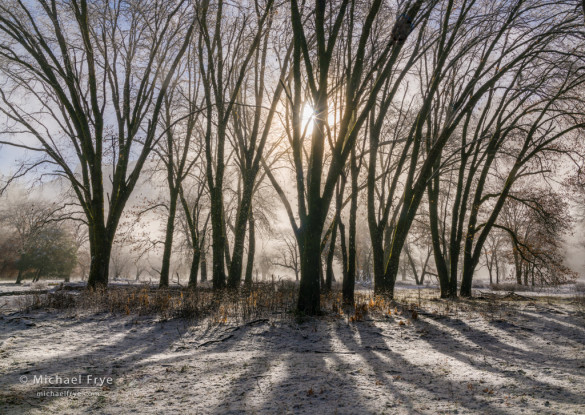
Sun breaking through fog in an oak grove, Yosemite, 8:06 a.m. yesterday
Friday’s storm got cold enough to drop a couple of inches of snow on Yosemite Valley. The storm cleared during the night, but showers lingered until the wee hours Saturday morning. It seemed possible that we might find some mist at sunrise, so Claudia and I drove up early to Yosemite Valley.
Indeed there was some mist, and broken clouds overhead. That seemed like a perfect combination for Tunnel View; if the clouds lit up it would be a gorgeous sunrise from there. But soon after I arrived at Tunnel View the clouds dissipated. There was still some mist down in the valley below, but it would take awhile for the sun to get high enough to light that mist, and without clouds to block it the sun would be right in my face, making it difficult to avoid lens flare.
(more…)
by Michael Frye | Sep 22, 2015 | Night Photography, Photography Tips
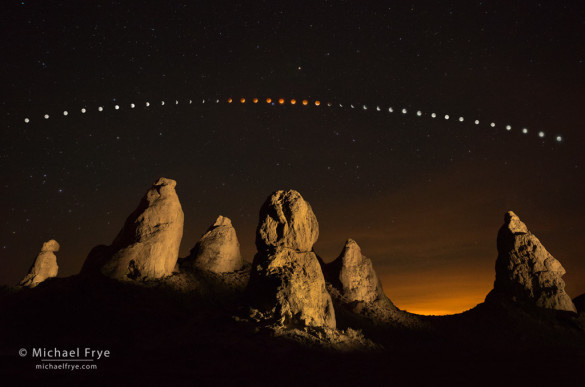
Lunar eclipse sequence, April 14th and 15th, 2014, Trona Pinnacles, CA, USA
We’re going to get another chance to photograph a lunar eclipse this Sunday evening in North America and South America (or early Monday morning in Europe and Africa).
This eclipse also coincides with the moon’s perigee, meaning that the moon will be at its closest point to the earth during its orbit, and will look bigger than usual. The media is going to make a big deal about this “supermoon,” but the moon will only look seven percent larger than average, a difference that won’t be readily apparent to the naked eye, much less in photographs.
However, every total lunar eclipse is special – a spectacular event to view and photograph. And unlike the last one in April, this one will feature a long total eclipse phase.
(more…)
by Michael Frye | Jul 26, 2015 | Photography Tips
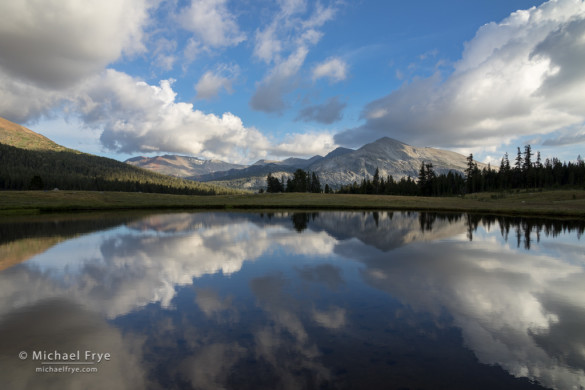
Clouds and Mammoth Peak reflected in an alpine tarn, Yosemite (1/90th of a second)
I love mirror reflections. The symmetry they create, with the bottom of the photograph mimicking the top, almost automatically adds repetition and creates patterns, helping to unify the image and give it rhythm.
The photograph above is a good example. I made this about two weeks ago near Tioga Pass, with some fantastic clouds passing by late in the afternoon. It’s not a perfect mirror, as the water is slightly rippled, but it’s close enough. The clouds and their reflections form a big X through the picture, a pattern that echoes some of the diagonals in the mountains. This design draws your eye from the middle of the frame out to the corners, giving the image a sense of dynamic energy. None of that would happen without the mirror reflections.
On the other hand, I love rippled water too. (more…)
by Michael Frye | Jun 11, 2015 | Light and Weather, Photography Tips
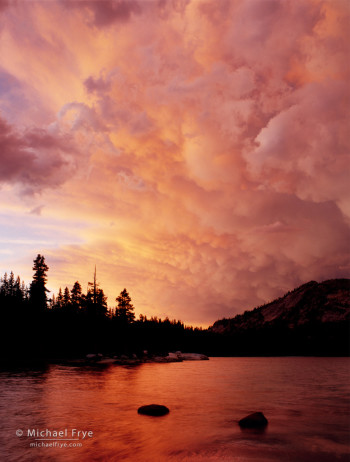
Sunset clouds over Tenaya Lake, Yosemite NP, CA, USA
I haven’t had many opportunities to get into the Yosemite high country since Tioga Pass opened, but I hope to head up there soon – maybe even this afternoon, since it looks like some clouds are building. Clouds and thunderstorms always make the summer days in the high country interesting, and potentially photogenic.
This photograph, from July of 2003, shows one of the most spectacular cloud formations I’ve ever seen. Claudia and I were in Tuolumne Meadows, and watched and photographed a thunderstorm move through from east to west. I hoped that after the storm passed we’d see some interesting light, but no such luck – it was just overcast. So I decided to follow the storm, and drove west toward Tenaya Lake.
We stopped near the eastern end of the lake. I got out of the car and looked out to the west, but the scene didn’t look very interesting in that direction. Then I looked over my shoulder. Holy crap! I saw this turbulent line of clouds, lit by the setting sun, and knew immediately that I was in the wrong spot – I needed to be on the other side of the lake.
(more…)
by Michael Frye | Mar 22, 2015 | Photography Tips
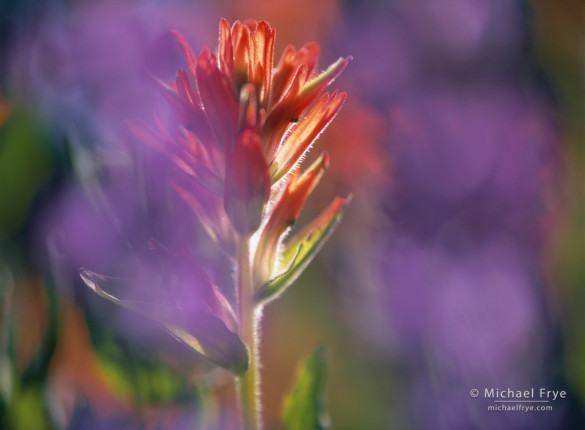
Paintbrush and lupine near Tioga Pass, Yosemite NP, CA, USA
Although spring officially began two days ago, here in California we’ve had springlike conditions since February, while in the northeast spring is just a rumor. But flowers will bloom everywhere, eventually, and it’s a great season for photography.
Though I usually prefer to photograph flowers as part of a landscape, sometimes I enjoy doing closeups as well. This image was made in the Yosemite high country a few years ago, with part of a paintbrush in focus, and out-of-focus lupines in the foreground. This technique of using out-of-focus flowers to create a wash of color, and an impressionistic look, is fun to try, but tricky. It requires a densely-packed group of flowers, and a lot of experimentation. Here are some tips:
(more…)
by Michael Frye | Jan 29, 2015 | Photography Tips
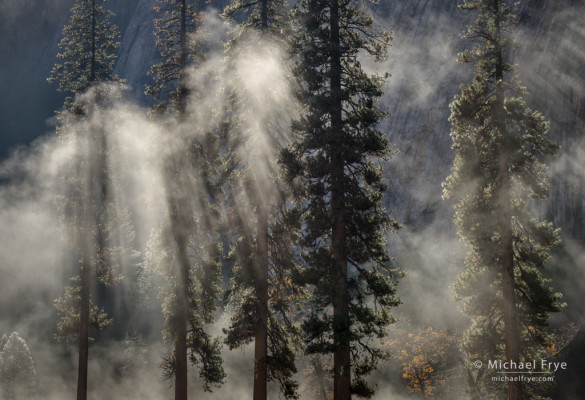
Ponderosa pines in mist, El Capitan Meadow, Yosemite
Natural light comes in an infinite variety of beautiful flavors. I love them all, but if I had to pick a favorite, it would probably be backlight, because it consistently delivers some of the most interesting images. All of the photographs from my last two posts, the ones from above the fog layer, were made with the camera pointing toward the sun. The photograph above, one I haven’t posted here before, captures a moment when backlit mist rose into the pines in Yosemite’s El Capitan Meadow. This next image, voted my top photograph of 2014, was also lit from behind, with the sun just above the frame:
(more…)














